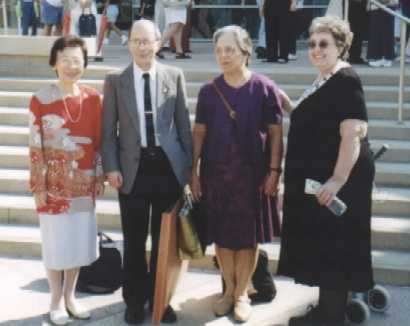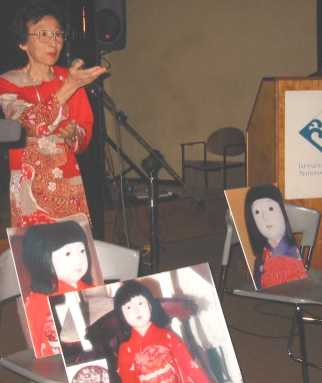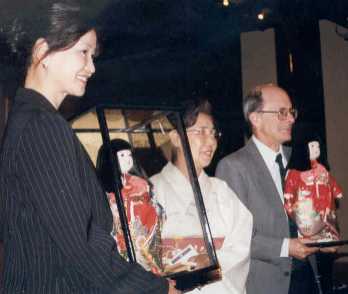|
|
|

|

|
Michiko Takaoka; Sidney Gulick, 3d;
Frances Gulick; Rosie Skiles (left to right)
|
|
|
On August 10, 2002, the Japanese American
National Museum in Los Angeles sponsored a special public program in
conjunction with its exhibition, "Passports to Friendship: Celebrating
75 Years of U.S.-Japan Friendship Doll Exchange." This exhibition from
July 27 to October 13 features several Japanese and American Friendship Dolls
exchanged in 1927.
The afternoon program on August 10 included
talks by several experts, who provided insight into past and present
people-to-people projects intended to better relations between the U.S. and
Japan.
- Noriko Kohno - Her great-grandfather, Eiichi Shibusawa, was involved in
many activities to promote improved relations between Japan and America.
In 1927, he helped facilitate the return exchange of 58 gorgeous Japanese
dolls to the children of America. Mrs. Kohno is the wife of the Consul
General of Japan in Los Angeles.
- Sidney Gulick, 3d
- Since 1986, he and his wife Frances have sent over 150 dolls to
elementary schools and kindergartens throughout Japan. His grandfather is
Dr. Sidney Gulick, the originator of the project to send dolls to Japan in
1927 in order to foster friendship and peace between Japan and America.
- Rosie Skiles
- She is the Friendship Doll Researcher for the Japanese Asian Doll
Enthusiasts (JADE). She has researched, published, and spoken extensively
about the missing Japanese Friendship Dolls and has assisted in finding
five of these original dolls.
- Michiko Takaoka
- She has visited all of the 44 original Japanese Friendship Dolls located
to date, and in 1993 she also helped to institute a program to give
Japanese dolls to American schools. She currently serves as the Director
of the Japanese Cultural Center at Mukogawa Fort Wright Institute in
Spokane, Washington.
|
|
|

|
|
|
Mrs. Takaoka talks on Japanese Friendship Dolls.
Enlarged photos of Miss Tokushima, Miss Aomori, and Miss Hiroshima (left to
right)
|

|
|
|
Noriko Kohno began the program by describing
her great-grandfather's idea of "international goodwill founded on love
of humanity." The exhibition at the Japanese American National Museum
gave her an opportunity to review her past, and she was impressed by her
great-grandfather's progressive vision related to his support of the 1927
doll exchange.Sidney Gulick, 3d, then
related the history of his grandfather, Dr. Sidney Gulick, and the reasons
why he advocated sending dolls to Japan as a gesture of friendship and peace.
Relations between the U.S. and Japan were deteriorating in the 1920s, and
Japanese immigrants living in America suffered especially harsh treatment.
Dr. Gulick believed that children were the key to future peace between the
two countries, so he wanted to involve children in a project of friendship
that would have lasting results. Mr. Gulick, 3d, has continued the tradition
of his grandfather by sending about ten dolls a year to Japanese elementary
schools and kindergartens. Next on the
program, Rosie Skiles enthusiastically described her long search for the
missing Japanese Friendship Dolls sent to America in 1927. Her correspondence
over many years with hundreds of people has resulted in many friendships and
has led to the discovery of several dolls. She used overhead slides to show
the unique characteristics of the special Japanese dolls sent in 1927, but
she emphasized several times that the most important distinguishing feature
is that each missing doll is 32 inches tall. Although 44 of the 58 Japanese
Friendship Dolls have been discovered, she will not be satisfied until all 58
have been found and are on display sending their message of friendship to the
children of America.
|
|
|
|
|

|

|
Kazuko Tamaoki (center) giving
two of her dolls to Sidney Gulick, 3d, and Noriko Kohno at the Japanese
American National Museum
|
|
|
A very special
guest from Nagoya, Japan, was introduced right before the break. Kazuko
Tamaoki is a master Japanese doll maker, and the Japanese American National
Museum staff found out only the week before the program that she would be
visiting LA for the Friendship Doll program and exhibition. During the
presentation of Rosie Skiles, she related a story of Mrs. Tamaoki's amazing abilities. The
original kimono for one of the Japanese Friendship Dolls had been cut into
pieces for children to use since the great historical value was not realized
at that time. When Mrs. Skiles found out about this, she contacted Mrs.
Tamaoki, who was able to put the pieces back together and completely restore
the kimono to its original beauty. At the program on August 10, Mrs. Tamaoki
presented new Japanese dolls to both Sidney Gulick, 3d, and Noriko Kohno to
express her gratitude for their involvement in Friendship Doll activities.
Michiko Takaoka concluded the special program
with the interesting stories behind several of the Japanese Friendship Dolls.
- Miss Kantoshu - This doll was not discovered
until November 1998, when she called out in a antique show to two avid Japanese
doll collectors, Marv and Flo Herring, who were in attendance at the August
10th program.
- Miss Chosen - This doll was discovered in
1998 through the joint efforts of several individuals in Connecticut. Mrs.
Takaoka explained that this discovery was very special because none of the
individuals involved are doll collectors.
|
|
|
|
|

|

|
Banner Outside Japanese
American National Museum
|
|
|
- Miss Tokushima - This is the first Japanese
Friendship Doll that Mrs. Takaoka met, and ever since 1993 Miss Tokushima
has been the guest of honor at the annual Doll Festival (Hina Matsuri)
held at the Mukogawa Fort Wright Institute in Spokane, Washington.
- Miss Hiroshima - This doll was kept safely
during World War II in the home of a Japanese-American woman living in
Baltimore.
- Miss Aomori - A woman bought this special
doll long ago for $10, even though it was somewhat damaged and the kimono
sleeve was off. She took good care of the doll for 36 years before she
finally found out it is one of the 58 Japanese Friendship Dolls sent to
the U.S. in 1927.
Mrs. Takaoka showed enlarged photos of four of
the Japanese Friendship Dolls. She explained that several of the dolls were
damaged over time, with cracks, missing feet, broken legs, and faded kimonos.
However, 30 of the 44 dolls have been returned to Japan for repair and
restoration.
The afternoon program on "A Mission of
Friendship" provided the audience with a good understanding of the
history and purpose of the Friendship Dolls. The speakers' enthusiasm and
dedication showed everyone that the Friendship Dolls continue to play a
valuable role in teaching children the importance of international friendship
and peace and in fostering better relations between Japan and America.
|
|
|



